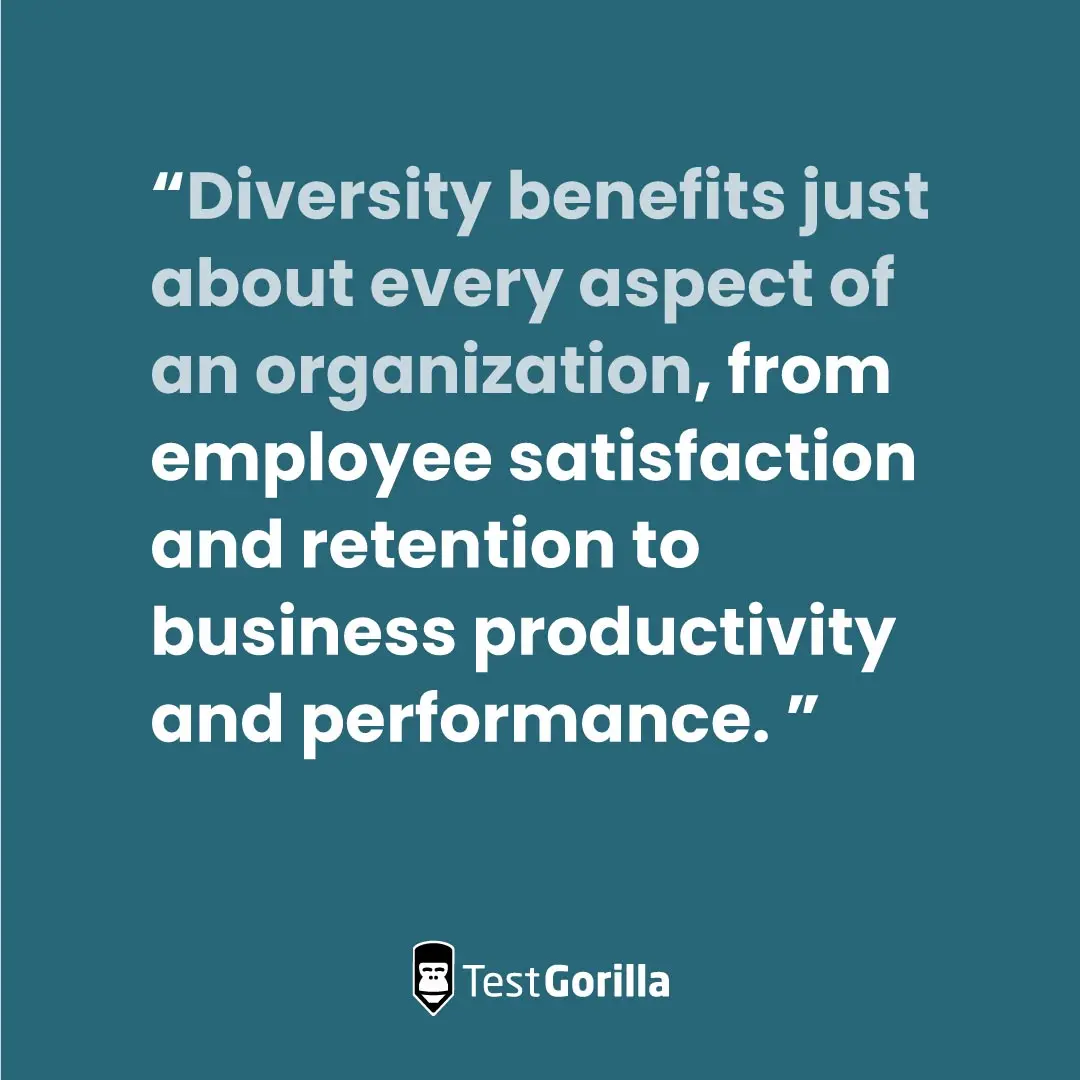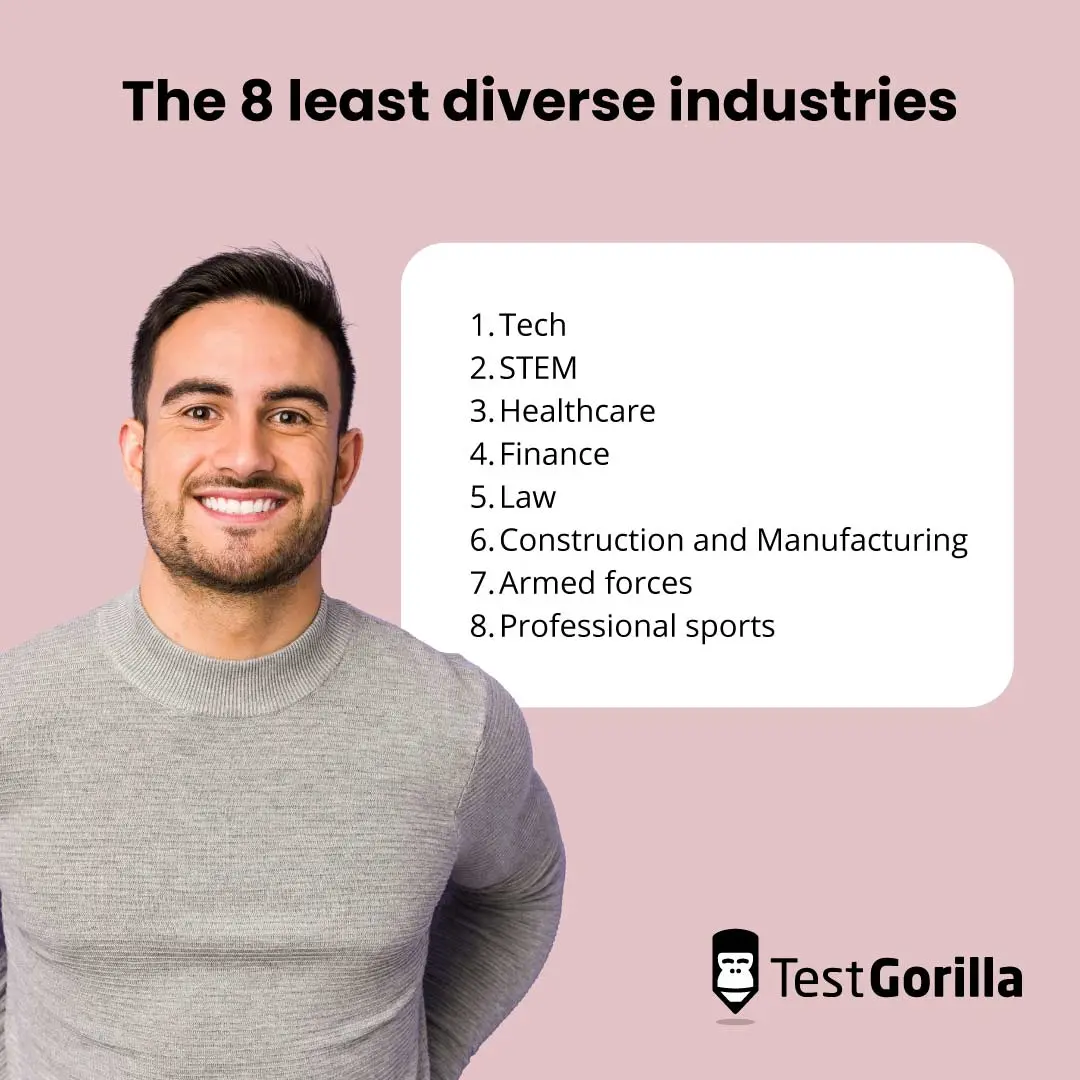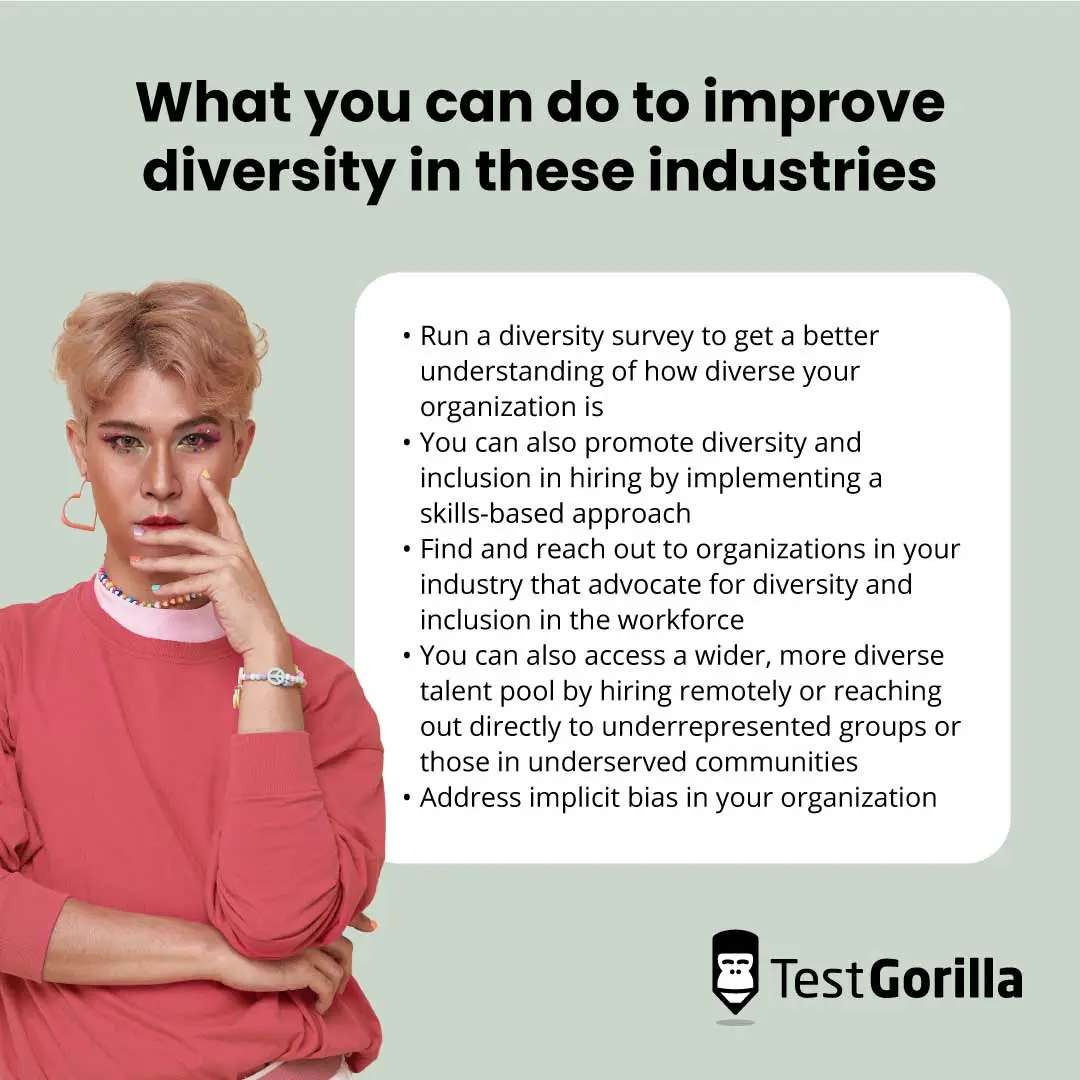Whether you’re a hiring manager or CEO, it’s easy to unquestioningly accept the norm – after all, we’re wired to follow the path of least resistance.
Perhaps you work at a software startup and are used to being surrounded by young, White, college-educated males. If so, that’s probably the image that comes to mind when you think of a programmer.
But, once you open your eyes to the lack of diversity in certain key industries, it’s hard to ignore.
From tech and healthcare fields to law and even professional athletics, certain sectors are falling behind in terms of equal representation among genders and ethnicities.
This is a shame because diversity benefits just about every aspect of an organization, from employee satisfaction and retention to business productivity and performance.
We’re going to take a look at the eight least diverse industries, and what you can do to improve diversity and inclusion in your sector.
Table of contents
- Which are the least diverse industries – and what are they doing to address that?
- 5 steps employers can take to improve diversity in these industries
- Don’t accept the status quo: Do your bit to improve diversity in your industry
- 5 steps employers can take to improve diversity in these industries
- Don’t accept the status quo: Do your bit to improve diversity in your industry
Which are the least diverse industries – and what are they doing to address that?
These 8 industries are all falling behind in diversity, equity, and inclusion (DE&I), making them the least diverse industries:
Tech
STEM
Healthcare
Finance
Law
Construction and Manufacturing
Armed Forces
Professional sports
This isn’t just a name-and-shame, and these industries struggle with diversity for different reasons. Let’s explore what’s being done to address the situation, both in the private and public sectors.
1. Tech
With men occupying 75% of computer science positions, and White employees in 62% of these roles, you’ll have a hard time finding diverse tech teams.
The numbers get even worse at leadership levels: Women only make up 18% of CIO and CTO positions in tech companies. Additionally, they tend to leave tech roles at a 45% higher rate than men. Half of women who take up a tech role drop out by the age of 35.
More than a third of them cite company culture as the reason they left their position.
The industry’s non-inclusive environment and lack of diversity create a vicious cycle, pushing out individuals who feel underrepresented within their companies.
And these disparities aren’t just bad for people in tech – they have an impact on the industry’s output as well. “The lack of inclusion in tech leads to gaps in what and who the industry caters to, which results in a lack of innovation,” says Matthew Ramirez, founder of Rephrasely. “It creates a disconnect between the perspective of tech workers and a real understanding of what problems different types of people have and how to solve them.”
Both the public and private sectors are taking steps to remedy inequality and a lack of diversity in the industry:
Girls Who Code and Code.org aim to educate young people on how to code and enter careers in computer science, especially women and people from ethnic minority groups.
InHerSight helps job-seeking women find tech companies that match certain criteria, like having women in leadership roles or supporting diversity.
The TechWomen program, sponsored by the US State Department, aims to educate and support the next generation of women leaders in STEM.
But because STEM is about more than tech, let’s take a closer look at the inequality issues in the STEM industries in general.
2. STEM
According to the Pew Research Center, Black and Hispanic workers remain underrepresented in STEM fields and women make up around a quarter of computing and engineering positions.
Jo Webber, PhD, founder and chief executive officer of AtlasJobs, highlights the impact of these figures: “STEM jobs tend to pay more than non-STEM jobs, but women are disproportionately going into non-STEM careers.” She also notes that women make up around half the US workforce but only around a quarter of STEM workers.
This plays into the persisting gender-wage gap, with women still earning just 82 cents to every dollar earned by men.
Simply put, we’ll never achieve equality in wider society unless women start entering higher-paid industries and roles. Despite the digital skills gap and STEM roles being the jobs of the future, women still tend to opt to study humanities. This makes them vulnerable to being left behind in the 4th Industrial Revolution. Also known as the “digital revolution,” this refers to widespread disruption to numerous industries owing to increasing automation and digitization of communication, production methods, and roles.
What Dr. Webber has witnessed, for example, through the participation of young women in the Million Women Mentors program, is that girls tend to drop out of STEM programs around the age of 15. However, progress is definitely being made: “Historically, when you asked kids to draw a scientist, they would draw a male. Thankfully, that’s slowly changing.”
That’s probably thanks to the actions of programs like:
All of which aim to create more opportunities for women in STEM careers.
Great Minds in STEM also works to promote STEM careers in underserved communities and MAES organization (Latinos in Science and Engineering) aims to boost Latino leadership and representation in STEM disciplines.
3. Healthcare
While women are generally underrepresented in STEM, they make up almost three-quarters of healthcare practitioners and technicians. However, it’s not all blue skies here either.
Dr. Webber notes that: “A large percentage of healthcare workers are females but, because of the roles they fill, there’s still a significant pay gap.”
Kelly Robinson, the chief executive officer and founder of recruiting firm PKRecruiting, emphasizes that, while the majority of nursing roles are filled by women, “when you get up to the administration level, you primarily see White males.”
A 2022 report found that, despite the fact that around nine in ten nurses are women, the median salary for a male nurse is $14,000 higher than for a female nurse.
Diversity isn’t only an issue in the nursing profession. The proportion of Black doctors in the US has grown by a meager 4% since the beginning of the 20th century. The share of Black male physicians also hasn’t changed since the 1940s.
A big roadblock to entering the medical profession is accessibility because schooling is incredibly expensive and lengthy. Medical students spend four years studying and three to seven years as a resident, accruing an average of more than $200,000 in debt.
It’s no surprise that the cost of medical school combined with expenses related to preparing for the Medical College Admission Test (MCAT) and applying to programs can be prohibitive for people from low-income or underserved communities.
Additionally, the lack of representation in medicine impacts young people’s beliefs about their ability to access the profession.
To counteract this, programs like the American Medical Association’s “Doctors Back to School” Day help to connect physicians with elementary and high schools in underserved areas to open students’ eyes to the possibility of joining the profession.
4. Finance
Finance is another problematic sector in terms of diversity. Dr. Webber highlights that: “You’ll see some of the worst DE&I numbers in the financial sector – it’s still mainly older White males operating at senior level.”
Men hold 64% of corporate leadership positions in finance, with just 23% of these roles occupied by White women and a mere 4% by Black, Latina, and Asian women.
Women also only hold around a quarter of executive management banking positions among 28 major US banks. Additionally, less than a quarter of financial planners are women and more than 80% of people who work as certified financial planners are White.
A recent report found that fewer than one in ten US financial firms (which includes mutual funds, hedge funds, and private equity firms) are minority or women-owned. These firms also proportionality control a lower percentage of capital than firms run by White males.
These figures aren’t reflective of performance, however. The same report states: “We ultimately find no statistically significant differences in performance between diverse- and non-diverse-owned funds across asset classes…the central story from [our analysis] is that performance is empirically indistinguishable among minority-owned, women-owned, and other firms.”
Thankfully, there are various organizations working to empower women and Black and Latino people and facilitate their access to the finance industry:
100 Women in Finance offers education and professional programming and organizes visibility programs with the aim of “elevating the public profile of female professionals.”
Wall Street Bound runs a six-month immersive training program called “Wall Street Direct” that prepares diverse students for jobs in the financial services industry.
The Greenwood Project runs a college internship program that prioritizes diverse students from underserved backgrounds who want to explore a career in finance.
5. Law
The American Bar Association recently found that 81% of US lawyers are White. Hispanic people make up just 5.8% of legal professionals and Black lawyers account for 4.5% of the industry.
While the percentage of female lawyers has grown 5% in the past decade, women still make up fewer than 40% of all lawyers.
Unfortunately, the legal industry does suffer from a lack of diversity. There are several reasons for this, including a lack of diversity in law schools, a lack of mentorship and sponsorship for underrepresented groups, and a general lack of initiatives to address these issues within the industry.
CL Mike Schmidt, trial lawyer at Schmidt & Clark
This homogeneity can have serious implications: A lack of diversity in the legal industry results in similar perspectives shaping legal outcomes. This can lead to a lack of representation for certain groups and generally low levels of innovation.
However, these organizations are working to increase both gender and racial diversity in the profession:
The National Association of Women Lawyers provides representation, advocacy, and resources to advance women in the legal profession.
The National Bar Association is the largest global network of Black American lawyers and judges. It works to improve the legal system and increase diversity in the field.
The National Association of Minority and Women Owned Law Firms aims to foster diversity and achieve equity by creating a network of minority- and women-owned legal firms.
6. Construction and Manufacturing
Though they’re distinct industries, there are similar diversity issues in the construction and manufacturing sectors. With women making up less than an eighth of the construction workforce and under a third of manufacturing positions, the gender disparities in these industries are clear.
Additionally, Black workers make up just 6.7% and 10.8% of the construction and manufacturing industries respectively, which falls below the group’s overall representation in the US labor force (12.6%).
For construction firms to remedy this issue, they need to make diversity and inclusion efforts a priority.
However, there are external organizations advocating for more equity in these industries:
The National Association of Women in Construction educates and supports women in the industry, helping them advance their careers and become leaders.
The National Association of Minority Contractors also advocates for minority trade workers and undocumented construction industry workers.
Like the tech industry, a lack of representation is one reason these sectors are so male-dominated. Manual labor tends to be gendered male, just as caregiving roles like nursing are perceived as “female.” As long as little boys are given Tonka trucks and building blocks, while little girls get dolls, this is unlikely to change. Similarly, many children have grown up watching Bob the Builder – but Betty the Builder has yet to make her screen debut.
It will take more than just advocating for women and minorities in these sectors to improve equality: mindset change is also required at all levels. Changing our perception of who “fits” different roles is the only way to open people’s eyes to the opportunities that await them and ditch outdated, limiting stereotypes.
7. Armed forces
A lack of gender diversity in the armed forces doesn’t come as much of a surprise. For decades, women could be involuntarily discharged from the military for becoming pregnant. Today, they make up just 17.3% of active duty members of the military.
But discrimination in the armed forces goes beyond male vs female: It wasn’t until recently that transgender people were even permitted to serve in the army.
The lack of racial diversity remains an issue as well. While African Americans make up 19% of the active duty enlisted members of the armed forces, they only comprise 9% of military officers.
The Department of Defense itself also admits: “More racial diversity exists among enlisted members than officers,” demonstrating a lack of equality in leadership positions.
The DoD claims it’s taking steps towards becoming more inclusive. For example, increasing scholarships and outreach programs at minority-serving institutions like historically Black colleges and tribal colleges and removing aptitude test barriers that negatively impact diversity.
The military is also finally becoming more inclusive for mothers: The recent Parenthood, Pregnancy, and Postpartum Army Directive helps new mothers transition back into duty and supports soldiers who want to be parents while still advancing their military career.
8. Professional sports
One of the most glaring examples of the gender pay gap is in professional sports.
While the average Women’s National Basketball Association (WNBA) player earns around $100,000 per year, the average National Basketball Association (NBA) player takes home more than $9 million. Even the highest-earning WNBA players make under $230,000 annually, while the NBA’s highest-paid athlete, Stephen Curry, is earning almost $50 million for the 2022-2023 season.
Additionally, while you might think you see racial diversity on the field, things look very different off it.
Even though Black football players make up more than half of all National Football League (NFL) players, The Washington Post found that only 11% of the league’s head coaches since 1990 have been Black.
In fact, Black NFL coach Brian Flores is taking the NFL to court over discrimination charges, and he’s not the first: For things to change in athletics, historically, it’s taken the actions of brave athletes and members of the industry to demand equality.
Take Billie Jean King for example, who founded the Women’s Tennis Association and fought for gender pay equality in the sport. Now, female tennis players earn the same winnings as men for the four Grand Slam tournaments.
And after fighting for equal pay, the US Women’s Soccer Team is finally being paid as much as the men’s team, despite the women having won a record-setting four World Cup titles (more than any other women’s team in the world), while the men have yet to win their first.
Finally, LGBTQ+ representation still has some way to go in professional athletics. Professional soccer has still only seen a handful of openly gay male players. Figures are higher in the women’s game, suggesting a more tolerant environment.
Changes are slowly happening. For example, the first openly transgender Olympian, New Zealand weightlifter Laurel Hubbard, competed at the 2020 summer games in Tokyo. In the NFL, Jennifer King became the first Black woman assistant coach in 2021, and Sandra Douglass became the first Black woman team president when she signed on with the Las Vegas Raiders in 2022.
5 steps employers can take to improve diversity in these industries
If you’re in any of these industries, these figures can be disheartening. However, if you’re in HR and recruitment, you have the power to remedy the situation, starting with your own company.
Here are a five ideas to improve diversity in your organization and industry:
Run a diversity survey to get a better understanding of how diverse your organization is. This will also help you understand how your employees view your diversity and inclusion efforts. You can take an honest look at the areas where you need to improve and learn whether your people feel your culture is inclusive.
Promote diversity and inclusion in hiring by implementing a skills-based approach. Our 2022 State of Skills-Based Hiring report found that skills-based hiring has a 91.1% success rate in improving workplace diversity. It levels the playing field for diverse candidates by analyzing them for their skills rather than their education and background.
Find and reach out to organizations in your industry that advocate for diversity and inclusion in the workforce. Partner with them to create outreach and educational programs.
Reach out directly to underrepresented groups or those in underserved communities to introduce them to opportunities they might not have been aware of before.
Address implicit bias in your organization. Though it can help, implicit bias training isn’t enough when used in isolation or as a one-off initiative. To be effective, it should be combined with other actions on an ongoing basis.
This is why you need to take actions like adopting skills-based hiring and stop emphasizing resumes and degrees during recruiting. In doing so, you minimize degree inflation and help tear down the paper ceiling. Candidates get more access to opportunities, and employers get access to more talent. It’s a win-win way to increase diversity if your sector is among the least diverse industries.
Don’t accept the status quo: Do your bit to improve diversity in your industry
Diversity in the workforce has come a long way. In 1970, women made up just around 40% of the labor force; today, they comprise almost half of employed adults in the US alone. Many sectors, such as STEM, have seen gradual diversity gains across the past decade – but there’s still a long way to go.
From construction to the military, a lack of representation, barriers to entry, and outdated hiring and compensation practices plague the sectors explored in this post. The good news is, you can start tackling the problem today by overhauling your recruitment processes and implementing skills-based hiring.
This levels the playing field for diverse candidates by focusing on their relevant skills and fit for the role rather than their background, work experience, or qualifications. With skills-based hiring, you can open up opportunities for candidates from underserved communities or underrepresented groups, which helps you hire more diverse teams and transform your business.
If you’re in any of these industries, these figures can be disheartening. However, if you’re in HR and recruitment, you have the power to remedy the situation, starting with your own company.
5 steps employers can take to improve diversity in these industries
If you’re in any of these industries, these figures can be disheartening. However, if you’re in HR and recruitment, you have the power to remedy the situation, starting with your own company. Here are five ideas to improve diversity in your organization and industry:
Run a diversity survey to get a better understanding of how diverse your organization is. This will also help you understand how your employees view your diversity and inclusion efforts. You can take an honest look at the areas where you need to improve and learn whether your people feel your culture is inclusive.
Promote diversity and inclusion in hiring by implementing a skills-based approach. Our 2022 State of Skills-Based Hiring report found that skills-based hiring has a 91.1% success rate in improving workplace diversity. It levels the playing field for diverse candidates by analyzing them for their skills rather than their education and background.
Find and reach out to organizations in your industry that advocate for diversity and inclusion in the workforce. Partner with them to create outreach and educational programs.
Reach out directly to underrepresented groups or those in underserved communities to introduce them to opportunities they might not have been aware of before.
Address implicit bias in your organization. Though it can help, implicit bias training isn’t enough when used in isolation or as a one-off initiative. To be effective, it should be combined with other actions on an ongoing basis.
This is why you need to take actions like adopting skills-based hiring and stop emphasizing resumes and degrees during recruiting. In doing so, you minimize degree inflation and help tear down the paper ceiling. Candidates get more access to opportunities, and employers get access to more talent. It’s a win-win way to increase diversity if your sector is among the least diverse industries.
Don’t accept the status quo: Do your bit to improve diversity in your industry
Diversity in the workforce has come a long way. In 1970, women made up just around 40% of the labor force; today, they comprise almost half of employed adults in the US alone. Many sectors, such as STEM, have seen gradual diversity gains across the past decade – but there’s still a long way to go.
From construction to the military, a lack of representation, barriers to entry, and outdated hiring and compensation practices plague the sectors explored in this post. The good news is, you can start tackling the problem today by overhauling your recruitment processes and implementing skills-based hiring.
This levels the playing field for diverse candidates by focusing on their relevant skills and fit for the role rather than their background, work experience, or qualifications. With skills-based hiring, you can open up opportunities for candidates from underserved communities or underrepresented groups, which helps you hire more diverse teams and transform your business.
Related posts
Hire the best candidates with TestGorilla
Create pre-employment assessments in minutes to screen candidates, save time, and hire the best talent.
Latest posts
The best advice in pre-employment testing, in your inbox.
No spam. Unsubscribe at any time.

Hire the best. No bias. No stress.
Our screening tests identify the best candidates and make your hiring decisions faster, easier, and bias-free.
Free resources
This checklist covers key features you should look for when choosing a skills testing platform
This resource will help you develop an onboarding checklist for new hires.
How to assess your candidates' attention to detail.
Learn how to get human resources certified through HRCI or SHRM.
Learn how you can improve the level of talent at your company.
Learn how CapitalT reduced hiring bias with online skills assessments.
Learn how to make the resume process more efficient and more effective.
Improve your hiring strategy with these 7 critical recruitment metrics.
Learn how Sukhi decreased time spent reviewing resumes by 83%!
Hire more efficiently with these hacks that 99% of recruiters aren't using.
Make a business case for diversity and inclusion initiatives with this data.




















